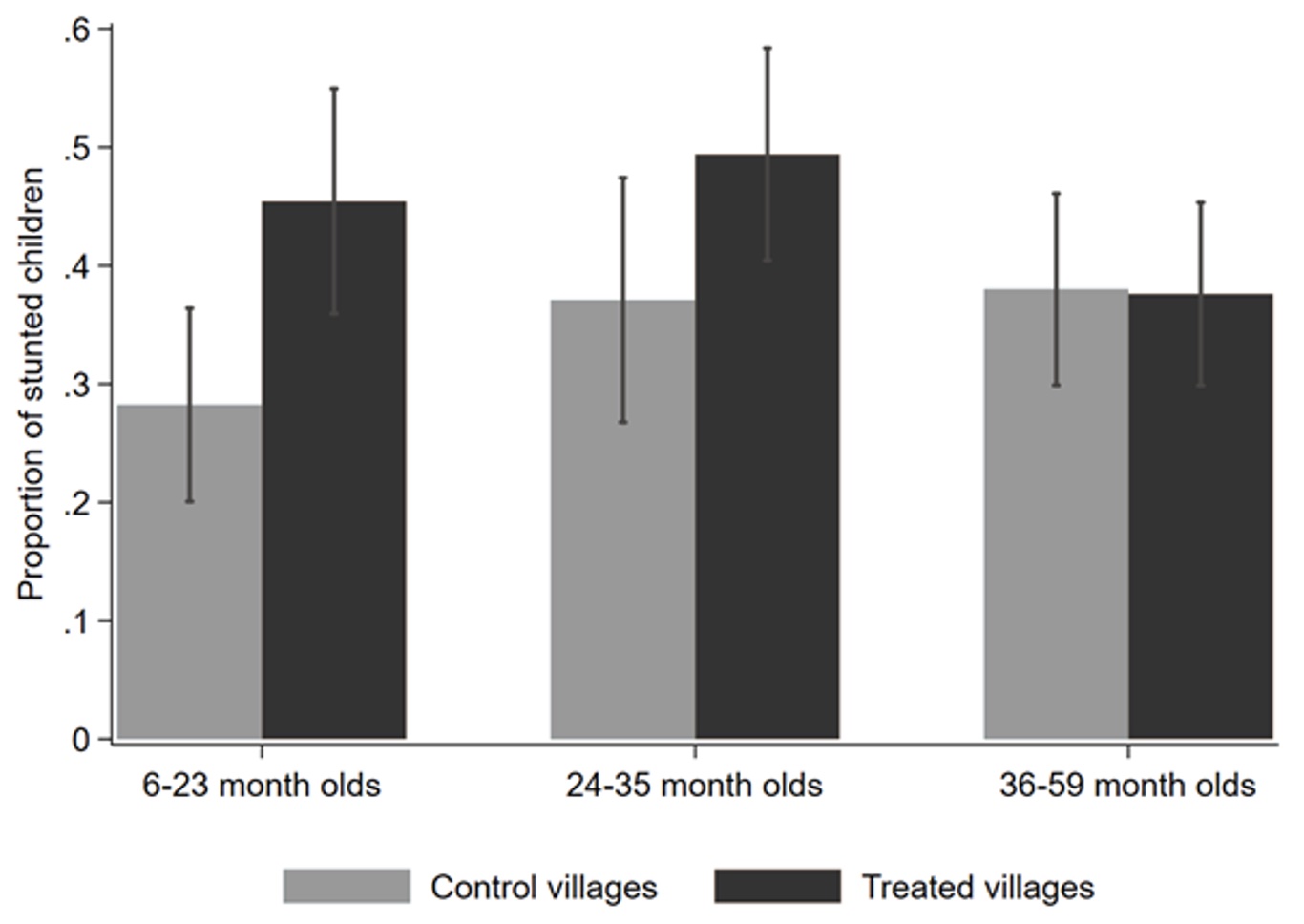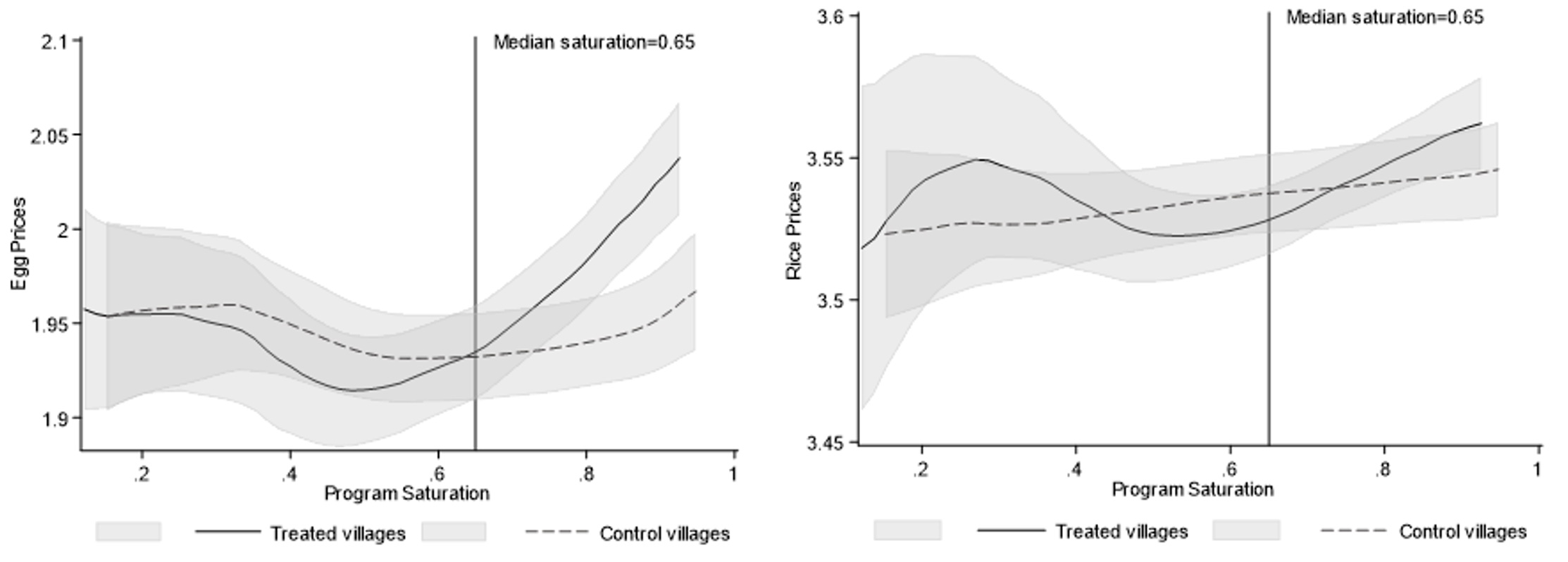
Cash transfers raised food prices and increased stunting among children from ineligible households in remote and poor areas
Over the last two decades, cash transfer programmes, including conditional cash transfers (CCTs), have become a staple of anti-poverty policies around the world. As of ten years ago, approximately 380 million households received them in low- and middle-income countries (World Bank 2014). These programmes typically provide cash payments to poor families, and are sometimes contingent on certain behaviours, such as regular school attendance or visits to health clinics. Such programmes have been shown to have many benefits, including reducing poverty (Parker and Vogl 2018), increasing school enrolment and attendance (Millán et al. 2019), improving child nutrition (J-PAL 2020), and increasing dietary diversity (Hidrobo et al. 2014). However, recent research reveals that despite the positive impacts on intended beneficiaries, these programmes can have broader, sometimes negative, community-level effects.
Market-level effects of cash transfers
These community-level effects can be beneficial, with increased consumption by non-beneficiaries through a rise in informal risk-sharing (Angelucci and De Giorgi 2009) and greater local economic activity (Muralidharan et al. 2019, Egger et al. 2019). Despite such positive spillover effects on the local economy, there is little evidence for price effects on basic commodities like food. Cunha et al. (2019) find that cash transfers have no effect on local prices (although a working paper version showed a small price increase from cash transfers in ‘underdeveloped’ areas). Beegle et al. (2017) find evidence of increased food insecurity among non-beneficiaries in the context of Malawi’s Social Action Fund, which the authors speculate may have occurred because the fund affected local prices – to the detriment of ineligible households – but data limitations prevent them from pinpointing the mechanism.
A new look at price effects
In our recent study (Filmer, Friedman, Kandpal, and Onishi 2021), we identify a new local market spillover effect of CCTs on prices of hard-to-transport items, such as perishable foods. Economic theory suggests that if a CCT channels a significant sum of money into a small and isolated village economy, local commodity prices may increase, which can in turn have consequences for households that are ineligible for the transfer.
We study this potential spillover in the context of the Philippine CCT, Pantawid, piloted in 2008. For beneficiaries, the impacts were unambiguously positive. In previously published work, we used a 31-month follow-up survey conducted for the randomised impact evaluation of the programme to show that the programme improved the nutritional status of younger children among beneficiaries – an impact not seen in other CCT evaluations at such an early implementation stage (Kandpal et al. 2016). Most notably, we estimated a 40% decrease in severe stunting, which is a long-run marker of malnutrition (Hoddinott et al. 2013, Galasso and Wagstaff 2019). Examining potential pathways for this encouraging impact on beneficiary children’s health outcomes, we found that the programme significantly increased children’s intake of protein-rich food, an important factor in avoiding childhood stunting (Puentes et al. 2016, Iannotti et al. 2017, Heady et al. 2018).
Ineligible children’s nutrition
We leverage the same RCT to show that this CCT also generated negative spillovers on households with income above the relatively low threshold for participation, equivalent to US$ 2.15 per day per capita. Regression results comparing young children from these ineligible households in treated villages to young children from similar ineligible households in control villages show that stunting of young children increased by 34%. Figure 1 shows that stunting, which primarily develops over the first three years of a child’s life, was higher in the treated villages – but only for children born after the programme was introduced (i.e. 31 months before these data were collected). Children born before the programme had similar stunting rates in treated and control villages. This differential pattern in stunting rates suggests that the CCT did in fact lead to an increase in ineligible children’s malnutrition.
Figure 1 Proportion of stunted children in treatment and control villages

Note: Brackets indicate 95% confidence intervals.
Source: 2011 Pantawid impact evaluation survey.
To understand the reasons for these sobering and unintended consequences, we examine a number of data sources, including administrative data, the national household budget survey, and a survey of the pilot households. In line with theory, we find that increases in demand for nutritious food by programme recipients raised the prices of some key foods, particularly in remote areas where most – but not all – of the households received the cash transfer. This combination of remoteness and a large inflow of cash into the village caused a rise in the prices of perishable foods, chiefly animal-sourced proteins. For example, the price of fresh eggs increased between 5% and 8% on average, and as much as 25% in areas where a large percentage of households qualified for payments (top panel of Figure 2 below, where we term the proportion of eligible households from among total households the ‘programme saturation’ rate). At the same time, the price of non-perishable foods like rice remained unchanged (bottom panel of Figure 2), as these products are relatively easy to transport, even to remote villages.
Figure 2 Food prices fluctuations and programme saturation rates in treatment and control villages

Note: Estimated using kernel-weighted local polynomial regression. Bands represent 95% confidence intervals. Source: 2011 Pantawid impact evaluation survey.
Consistent with these patterns, we also find that increases in ineligible children’s stunting rates were concentrated in villages that were geographically remote and where the programme saturation rate was high.
Reconciling our findings with the literature
So why do we find price effects where other studies don’t?
- First, our sample of villages encompasses some of the poorest and most remote parts of the Philippines, meaning our study includes many villages where markets are not fully integrated with a regional production base.
- Second, the high rates of poverty in these villages mean that a large portion of the treated villages receives the transfer; on average, 65% of the households in study villages are eligible – at least twice that reported by Beegle et al. (2017) in Malawi or Egger et al. (2019) in Kenya. Ours is the only study in which non-beneficiaries are in the minority in such a substantial portion of the study villages.
- Third, it also means that even ineligible households – those that are non-poor as Pantawid defines poverty – are in fact quite vulnerable.
- Finally, we distinguish between perishable and non-perishable foods. This difference is key because the price increases only affect perishable foods that are more difficult to transport and thus exhibit a more limited supply response to any price increase.
Fortunately, the poverty and remoteness conditions that caused these negative spillovers for non-beneficiary households hold for less than 4% of households across the Philippines. But while this spillover affects a limited set of goods and a small proportion of the population, the increase in stunting among ineligible children means that the price increases can lead to economically significant consequences for those who experience them. This price spillover thus highlights the importance of thinking carefully about how to modify the design of cash programmes to avoid such unintended consequences in more poor and remote areas.
Policy implications
Several options could increase the poverty-fighting benefits of CCTs or other cash transfers while minimising negative spillovers. One is geographic targeting: in remote and poor villages, all households could be declared eligible, regardless of poverty status. A second option is for governments to pair the rollout of targeted transfers in remote locations with investments in transport infrastructure and supply chains. A third might be to provide in-kind transfers in the most remote areas. A fourth comes from recent Nobel Laureates Abhijit Banerjee and Esther Duflo, who have proposed a variation on the idea of a universal basic income. Their idea, called universal ultra basic income, entails a small transfer to a broadly defined set of poor households, and a long-term study currently underway pilots a version of this (Banerjee et al. 2020). While researchers build the evidence to inform policy decisions on the continuum of options between targeting and universality, policymakers and statistics offices should pay close attention to monitoring the prices of perishable, protein-rich foods during the implementation of cash transfer programmes to avoid unintentionally penalising ineligible households.
References
Abdul Latif Jameel Poverty Action Lab (J-PAL) (2020), "Using cash transfers to improve child health in low- and middle-income countries", J-PAL Policy Insights, Last modified May 2020.
Angelucci, M and G De Giorgi (2009), "Indirect Effects of an Aid Program: How Do Cash Transfers Affect Ineligibles' Consumption?", American Economic Review 99(1): 486-508.
Banerjee, A, A Kruger, P Niehaus, M Faye and T Suri (2020), "Universal Basic Income in Kenya", AEA RCT Registry, September 18, 2020.
Beegle, K, E Galasso and J Goldberg (2017), “Direct and indirect effects of Malawi's public works program on food security”, Journal of Development Economics 128: 1-23.
Cunha, J, G De Giorgi and S Jayachandran (2019), “The Price Effects of Cash Versus In-kind Transfers”, Review of Economic Studies 86(1): 240-281.
Egger, D, J Haushofer, E Miguel, P Niehaus and M W Walker (2019), “General equilibrium effects of cash transfers: experimental evidence from Kenya”, NBER Working Paper No. 26600.
Filmer, D, J Friedman, E Kandpal and J Onishi (2021), “Cash Transfers, Food Prices, and Nutrition Impacts on Ineligible Children”, The Review of Economics and Statistics.
Headey, D, K Hirvonen and J Hoddinott (2018), “Animal sourced foods and child stunting”, American Journal of Agricultural Economics 100(5): 1302-1319.
Hidrobo, M, J Hoddinott, A Peterman, A Margolies and V Moreira (2014), “Cash, food, or vouchers? Evidence from a randomized experiment in northern Ecuador”, Journal of Development Economics 107: 144-156.
Hoddinott, J, H Alderman, J R Behrman, L Haddad and S Horton (2013), “The economic rationale for investing in stunting reduction”, Maternal & Child Nutrition 9: 69-82.
Iannotti, L, C Lutter and C Stewart (2017), “Eggs in Early Complementary Feeding and Child Growth: A Randomized Controlled Trial”, Pediatrics 140(1).
Kandpal, E, H Alderman, J Friedman, D Filmer, J Onishi and J Avalos (2016), “A conditional cash transfer program in the Philippines reduces severe stunting”, The Journal of Nutrition 146(9): 1793-1800.
Millán, T M, T Barham, K Macours, J A Maluccio and M Stampini (2019), “Long-term impacts of conditional cash transfers: Review of the evidence”, The World Bank Research Observer 34(1): 119-159.
Muralidharan, K, P Niehaus and S Sukhtankar (2017), “General equilibrium effects of (improving) public employment programs: Experimental evidence from India”, NBER Working Paper No. 23838.
Parker, S W and T Vogl (2018), “Do conditional cash transfers improve economic outcomes in the next generation? Evidence from Mexico”, NBER Working Paper No. 24303.
Puentes, E, F Wang and J Behrman (2016), “Early Life Height and Weight Production Functions with Endogenous Energy and Protein Inputs”, Economics & Human Biology 22: 65-81.
World Bank, (2014), “A Model from Mexico for the World”, World Bank Group, Washington, D.C.
World Bank (2012), “Philippines conditional cash transfer program: Impact evaluation 2012 (English)”, World Bank Group, Washington, D.C.




